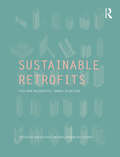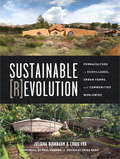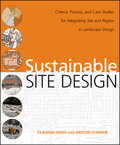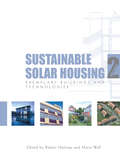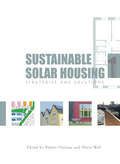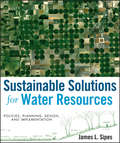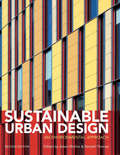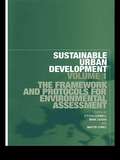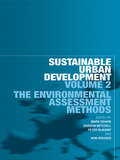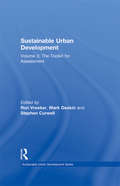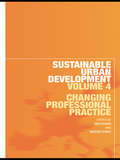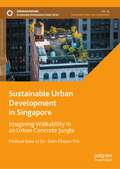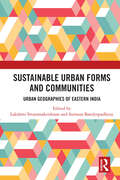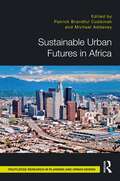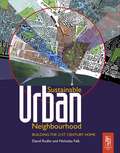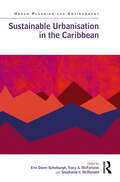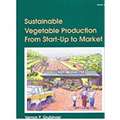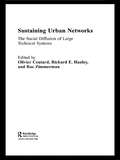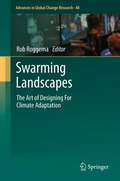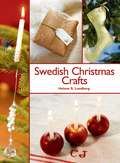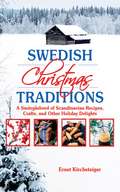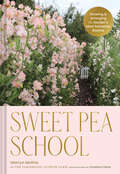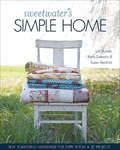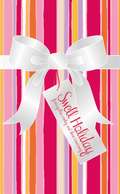- Table View
- List View
Sustainable Residential Interiors
by Annette Stelmack Debbie Hindman Associates III Kari FosterThe Second Edition of Sustainable Residential Interiors addresses cutting edge processes, strategies, and principles as well as details for in-depth product vetting criteria. Award-winning, leading interior designer Annette Stelmack shares her expertise from the perspective of LEED Building Design & Construction projects, healthy interiors, and chemical sensitivities, addressing principles, strategies, and solutions for design practitioners. A comprehensive update of the current state of the sustainable interior design industry is provided, including present and upcoming industry transformations, thought-leading principles, strategies and practices for project implementation, and fine points and resources for in-depth product vetting to support high-performing, healthy interiors. Sustainable Residential Interiors takes readers through an integrated design process, demonstrating relevant principles and practices that apply to essentially any interiors project toward creating an environment that is healthy, high-performing, functional, sustainable, and beautiful. In doing so, it: Promotes critical thinking about health and environmental issues in the building industry Features checklists and current resources, providing a "hands on" practical approach Addresses in-depth, applicable third party certifications and details on relevant building rating systems Provides in-depth strategies and criteria for fixed interior finishes, fixtures, equipment and furnishings Demonstrates successful, relevant, diverse and inspiring case studies Delivers comprehensive tools and resources for researching and vetting products' composition and chemical make-up. Evaluates all aspects of a building's interior to identify and implement methods that: save energy and water; reduce Co2 emissions and waste; improve indoor air quality free of toxins; and are responsive to environmental impacts Encourages forward-thinking by featuring inspirational statements from mentors, peers, and industry leaders Urges interior designers to commit to designing safe, healthy environments that are integral to a professional code of ethics, which ensure the delivery of positive outcomes for the client and any building's future occupants
Sustainable Retrofits: Post War Residential Towers in Britain
by Asterios Agkathidis Rosa Urbano GutiérrezPresenting the state-of-the-art in sustainable retrofits in post war residential towers, this book captures and re-informs the current intense refurbishing process that is taking place in Britain, which is part of a global phenomenon happening all over the world, as cities upgrade their building stock in an attempt to comply with governmental emission reduction targets. The authors present inspections of 20 sustainably retrofitted social housing towers, analysing their aesthetic and technical modifications, as well as the shifts occurring in their social structure. The authors use over 200 full colour plans, elevations, photographs, maps and illustrations to beautifully support the statistical and analytical information collected. Finally they include interviews with some of the architects who designed the retrofits, residents and key stakeholders to inform the conclusions.
Sustainable Revolution
by Paul Hawken Louis Fox Juliana Birnbaum Erika RandUrban gardeners. Native seed-saving collectives. Ecovillage developments. What is the connection between these seemingly disparate groups? The ecological design system of permaculture is the common thread that weaves them into a powerful, potentially revolutionary--or reevolutionary--movement. Permaculture is a philosophy based on common ethics of sustainable cultures throughout history that have designed settlements according to nature's patterns and lived within its bounds. As a movement that has been building momentum for the past 40 years, it now is taking form as a growing network of sites developed with the intention of regenerating local ecologies and economies. Permaculture strategies can be used by individuals, groups, or nations to address basic human needs such as food, water, energy, and housing. As a species, humans are being called forth to evolve, using our collective intelligence to meet the challenges of the future. Yet if we are to survive our collective planetary crisis, we need to revisit history, integrating successful systems from sustainable cultures. To boldly confront our position on the brink of the earth's carrying capacity and make changes that incorporate the wisdom of the past is truly revolutionary. Sustainable Revolution features the work of a worldwide network of visionaries, including journalists, activists, indigenous leaders and permaculturists such as David Holmgren, Vandana Shiva, Charles Eisenstein, Starhawk, Erik Assadourian, Victoria Tauli-Corpuz, Albert Bates, and Geoff Lawton. This beautifully photographed collection of profiles, interviews, and essays features 60 innovative community-based projects in diverse climates across the planet. Edited by anthropologist Juliana Birnbaum Fox and award-winning activist filmmaker Louis Fox, it can be read as an informal ethnography of an international culture that is modeling solutions on the cutting edge of social and environmental change. The research presented in the book frames the permaculture movement as a significant ally to marginalized groups, such as the urban poor and native communities resisting the pressures of globalization. Sustainable Revolution uplifts and inspires with its amazing array of dynamic activists and thriving, vibrant communities.From the Trade Paperback edition.
Sustainable Site Design
by Claudia Dinep Kristin SchwabSustainable Site Design introduces the core concepts of sustainability as applied to landscape architecture. Focusing on site-scale design, this book provides a regional framework for integrating sustainable practices throughout the design process. From landscape analysis to program and design development, each design phase is illustrated with detailed case studies covering a broad range of innovative built landscape architectural projects.
Sustainable Solar Housing: Exemplary Buildings and Technologies
by Robert Hastings Maria WallThis far-reaching and authoritative two-volume set examines a range of potential solutions for low-energy building design, considering different strategies (energy conservation and renewable energy) and technologies (relating to the building envelope, ventilation, heat delivery, heat production, heat storage, electricity and control). Energy and life-cycle impacts are considered as crucial factors, including passive and active solar use, daylighting and high efficiency conventional heat production. Each volume assesses the potential of these options in a variety of contexts, covering different housing types (apartment, row and detached) in cold, temperate and mild climates. The impressive list of expert authors from 14 countries includes a mix of internationally respected academics and practitioners, working together within the framework of a five-year International Energy Agency (IEA) research project. Volume 1 presents strategies and solutions, offering the reader a solid basis for developing concepts, considering environmental and economic concerns for housing projects in a variety of contexts. Volume 2 offers a detailed analysis of exemplary buildings in different European countries and examines the various technologies employed to achieve their remarkable performance. Aided by clear, full colour illustrations, it offers invaluable insights into the application of these technologies.
Sustainable Solar Housing: Volume 1 - Strategies and Solutions
by Maria Wall S. Robert HastingsThis far-reaching and authoritative two-volume set examines a range of potential solutions for low-energy building design, considering different strategies (energy conservation and renewable energy) and technologies (relating to the building envelope, ventilation, heat delivery, heat production, heat storage, electricity and control). Energy and life-cycle impacts are considered as crucial factors, including passive and active solar use, daylighting and high efficiency conventional heat production. Each volume assesses the potential of these options in a variety of contexts, covering different housing types (apartment, row and detached) in cold, temperate and mild climates. The impressive list of expert authors from 14 countries includes a mix of internationally respected academics and practitioners, working together within the framework of a five-year International Energy Agency (IEA) research project. Volume 1 presents strategies and solutions, offering the reader a solid basis for developing concepts, considering environmental and economic concerns for housing projects in a variety of contexts. Volume 2 offers a detailed analysis of exemplary buildings in different European countries and examines the various technologies employed to achieve their remarkable performance. Aided by clear, full colour illustrations, it offers invaluable insights into the application of these technologies.
Sustainable Solutions for Water Resources
by James L. SipesGet the single-source solutions guide to the sustainable management of water resources. Why is water the environmental issue? The answer is simple: without it, life on this planet could not exist. Yet, despite this fact, reckless consumption practices from a growing population are drying up the Earth's already limited water resources. Other factors, such as river and lake contamination, rising temperatures, and disproportionate geographic accessibility further contribute to the fresh water crisis. To confront this pressing concern, this enlightening guide, which covers over twenty case studies offering insights into real-world projects, uses a holistic, integrated approach to illustrate ways to preserve vital water supplies -- from green design remedies to encouraging greater personal responsibility. This book: Provides a basic overview of water resources, hydrology, current problems involving water resources, and the potential impact of global warming and climate change. Covers watershed planning, Best Management Practices, and potential design and planning solutions. Offers a concise overview of the issues affecting water use and management. Includes a full chapter dedicated to planning issues, and a full chapter covering site planning, design, and implementation. Sustainable Solutions for Water Resources takes a practical approach to head off a global water catastrophe by offering sensible measures that can be put in place immediately to promote a clean, plentiful flow of the Earth's most precious resource.
Sustainable Urban Design: An Environmental Approach
by Randall Thomas Adam RitchieBy the end of the twenty-first century it is thought that three-quarters of the world’s population will be urban; our future is in cities. Making these cities healthy, vibrant and sustainable is an exceptional challenge which this book addresses. It sets out some of the basic principles of the design of our future cities and, through a series of carefully-selected case studies from leading designers’ experience, illustrates how these ideas can be put into practice. Building on the first edition's original format of design guidance and case studies, this new edition updates the ideas and techniques resulting from further research and practice by the contributors. This book emphasises the enormous progress made towards exciting new designs that integrate good design with resource efficiency.
Sustainable Urban Development Volume 1: The Framework and Protocols for Environmental Assessment (Sustainable Urban Development Series #Vol. 1)
by Mark Deakin Martin Symes Steven CurwellBased on original research, this first volume of a set of groundbreaking new books sets out a framework for analyzing sustainable urban development and develops a set of protocols for evaluating the sustainability of urban development. Protocols included are for sustainable urban planning, urban property development, urban design, the construction, operation and use of buildings. Using these protocols, the book goes on to provide a directory of environmental assessment methods for evaluating the sustainability of urban development and also maps out how these assessment methods are being transformed to evaluate the environmental, economic and social sustainability of urban development. Web-based applications are increasingly being used to support this transformation and the contributors deftly cover this application and issues concerning the use of information and communication technologies for evaluating the sustainability of urban development are also dealt with. With its multidisciplinary approach, Sustainable Urban Development presents key new material for postgraduates and professionals across the built environment.
Sustainable Urban Development Volume 2: The Environmental Assessment Methods (Sustainable Urban Development Series #Vol. 2)
by Peter Nijkamp Mark Deakin Gordon Mitchell Ron VreekerIn this book, the second of a three-volume series, leading authorities on the methodology of environmental assessment provide a unique insight into questions of critical importance to sustainable urban development. Using the framework and protocols set out in Volume 1, Volume 2 examines how well the environmental assessment methods evaluate the ecological integrity of urban development and equity of the resulting resource distribution. The examination focuses on: the instruments of environmental assessment approaches to environmental assessment based in systems-thinking methods for environmental, economic and social assessments their use in evaluating the sustainability of urban development. The Sustainable Urban Development Series contains the research and debate of the BEQUEST (Building, Environmental Quality Evaluation for Sustainability) network funded by the European Commission. Together the books provide a framework, set of protocols, environmental assessment methods and toolkit for policy makers, academics, professionals and advanced level students in urban planning and studies, as well as other areas of the built environment.
Sustainable Urban Development Volume 3: The Toolkit for Assessment (Sustainable Urban Development Series)
by Mark Deakin Ron Vreeker Stephen CurwellThe third volume of the Sustainable Urban Development Series outlines the BEQUEST toolkit that helps link protocol with the assessment methods currently available for evaluating the sustainability of urban development. It details the decision support mechanisms developed for users of the system to guide them in selecting the appropriate assessment methods for a variety of evaluations.This book provides case studies drawn from locations across Europe, and also provides best practice examples demonstrating those protocols that planners, property developers and design and construction professionals have followed, and how they have selected the assessment methods they need to best evaluate the sustainability of cities, districts, neighbourhoods and buildings.
Sustainable Urban Development Volume 4: Changing Professional Practice (Sustainable Urban Development Series #Vol. 4)
by Ian Cooper Martin SymesThis new book explores how the professions responsible for enhancing the built environment's sustainability seek to deliver this new agenda, offering multi-perspective case studies and discussion to argue for a rethinking of the role of urban development professional. Showing how sustainability is rapidly becoming the norm for practitioners, the authors consider new types of professional knowledge, relationships between planning systems and property development, links between public and private sector organisations, ideas about long term responsibilities and new working practices for engaging with the public.
Sustainable Urban Development in Singapore: Imagining Walkability in an Urban Concrete Jungle (Sustainable Development Goals Series)
by Melissa Liow Li Sa Sam Choon-YinThis book offers theoretical and practical insights into land use, transport, and national policies in one of world’s well-known urban concrete jungle, none other than the Singapore city. The emphasis is situated on Singapore’s attempt to promote walking and cycling. Greater appreciation of walkability thrives on Singapore’s rich history, green city, people and the gastronomic kopitiam and hawker culture. The book offers a comprehensive coverage of walkability as a crucial component of urban design to reduce vehicular congestion with the associated carbon emissions, foster a healthy lifestyle and community participation and create jobs to help the economy. A high income per capita and an aging society, lessons drawn from Singapore’s experience will be useful to other societies. Scholars in sustainable tourism field, urban planners, government bodies, tourist boards, entrepreneurs, national parks board, residents, and inbound travellers will benefit from reading the book.
Sustainable Urban Forms and Communities: Urban Geographies of Eastern India
by Sumana Bandyopadhyay Lakshmi SivaramakrishnanThis volume discusses the patterns and trends of urbanization in West Bengal - one of the most urbanized states of India in the early part of the 20th Century. It focuses on the emerging urban landscapes of the state and neighbouring areas on building sustainable urban units and sustainable communities. The book explores the changing urban geographies of the emerging towns of the state and discusses how proper governance can help them to change into sustainable urban units. It presents the historical context of urbanization of West Bengal and traces the factors responsible for the urban primacy of the state. It discusses topics such as the development of the spatial patterns and urbanization, spatial trends of urban growth using remote sensing and GIS techniques, well-being and resilience in the urban society, impact of urbanization on the health status of its citizens, and decentralized governance for inclusive and sustainable development of cities. It also focuses on urban growth, land-use change and its impact on the urban environment. Based on empirical research, this book will be useful for students, teachers and researchers of geography, urban geography, urban studies, urban development and planning, regional planning urban sociology, politics, and urban economics. It will also be of interest to geographers, urban planners, community of geographers, professionals engaged in the discipline, and those interested in the urban geography of West Bengal and eastern India.
Sustainable Urban Futures in Africa
by Patrick Brandful CobbinahSustainable Urban Futures in Africa provides a variety of conventional and emerging theoretical frameworks to inform understandings and responses to critical urban development issues such as urbanisation, climate change, housing/slum, informality, urban sprawl, urban ecosystem services and urban poverty, among others, within the context of the sustainable development goals (SDGs) in Africa. This book addresses topics including challenges to spatial urban development, how spatial planning is delivered, how different urbanisation variables influence the development of different forms of urban systems and settlements in Africa, how city authorities could use old and new methods of land administration to produce sustainable urban spaces in Africa, and the role of local activism is causing important changes in the built environment. Chapters are written by a diverse range of African scholars and practitioners in urban planning and policy design, environmental science and policy, sociology, agriculture, natural resources management, environmental law, and politics. Urban Africa has huge resource potential – both human and natural resources – that can stimulate sustainable development when effectively harnessed. Sustainable Urban Futures in Africa provides support for the SDGs in urban Africa and will be of interest to students and researchers, professionals and policymakers, and readers of urban studies, spatial planning, geography, governance, and other social sciences.
Sustainable Urban Neighbourhood: The Sustainable Urban Neighbourhood
by David Rudlin Nicholas FalkThis successful title, previously known as 'Building the 21st Century Home' and now in its second edition, explores and explains the trends and issues that underlie the renaissance of UK towns and cities and describes the sustainable urban neighbourhood as a model for rebuilding urban areas.The book reviews the way that planning policies, architectural trends and economic forces have undermined the viability of urban areas in Britain since the Industrial Revolution. Now that much post-war planning philosophy is being discredited we are left with few urban models other than garden city inspired suburbia. Are these appropriate in the 21st century given environmental concerns, demographic change, social and economic pressures? The authors suggest that these trends point to a very different urban future.The authors argue that we must reform our towns and cities so that they become attractive, humane places where people will choose to live. The Sustainable Urban Neighbourhood is a model for such reform and the book describes what this would look like and how it might be brought about.
Sustainable Urbanisation in the Caribbean (ISSN)
by Stephanie V. McDonald Dawn Schoburgh, Edited by ErisSustainable Urbanisation in the Caribbean critically examines the socio-geographic context of island states, prioritising the nuanced experiences of Caribbean island states and territories that are largely considered small island developing states (SIDS), against the backdrop of the UN Sustainable Development Goals (SDGs).Increases in urban density place enormous pressure on existing infrastructures and natural resources, exacerbating social inequalities and environmental risks. While the UN SDGs aim to mitigate these risks, the reality of implementing these goals in the context of SIDS is complex. Whereas Sustainable Urbanisation in the Caribbean does not claim to be a comprehensive assessment of policy responses to the SDGs, this edited volume seeks to generate problem-focused, policy-relevant, demand-driven research, thereby permitting the geographical contexts of island states to contribute to the development of proper causal theory about sustainable urbanisation.This book will be of interest to students of public policy, urban sustainability and climate change, as well as government policy analysts, development practitioners, urban planners and UN agencies working in SIDS.
Sustainable Vegetable Production from Start-Up to Market (NRAES #104)
by Vernon P. Grubinger<P>Plan and manage profitable and environmentally friendly vegetable production. <P>Addresses the principles and practices essential to planning, launching, and managing a vegetable production business and the practical implications of sustainability.<P> Thirty-two profiles detail the experiences of individual vegetable growers and provide enterprise budgets for a number of crops.
Sustaining Urban Networks: The Social Diffusion of Large Technical Systems (Networked Cities Series)
by Olivier Coutard Rae Zimmerman Richard E. HanleyConsidering sustainability in its economic, environmental and social contexts, the contributors take stock of previous research on large technical systems and discuss their sustainability from three main perspectives: uses, cities, and rules and institutions.
Swarming Landscapes
by Rob RoggemaThis book advocates a fresh approach to planning that anticipates, rather than reacts to, the changes in climate currently in process. Today's spatial planning procedures rely on historical evidence instead of preparing for factors that by definition lie in the future, yet which are relatively uncontroversial: shortages of water, sea level rise and rises in average temperatures being but three examples. Arguing for more flexibility, the contributors view 'complexity' as the key to transforming the way we plan in order to better equip us to face uncertainties about our future environment.
Swedish Christmas Crafts
by Annika S. Hipple Helene S. LundbergStraight from a country famous for its Christmas celebrations, Swedish author Helene Lundberg goes into detail on everything necessary to make beautiful Christmas crafts with an authentic Swedish twist. This full-color book includes lists of necessary materials, step-by-step pictures of each project, and patterns in the back of the book so you get perfect results with every craft. From stockings, ornaments, and picture frames to creative gift wrappings, Christmas cards, and homemade candles, the simple and elegant projects in this book are easy enough to appeal to beginners, but exquisite enough to make even the newest crafter seem like an expert.
Swedish Christmas Traditions: A Smorgasbord of Scandinavian Recipes, Crafts, and Other Holiday Delights
by Ernst KirchsteigerHere readers will learn how to bring those warm traditions into their own homes, wherever they live. Included are instructions to make mulled wine, homemade peanut brittle, red candied apples, crisp pepparkakor, lightly browned Swedish meatballs, candles, wreaths, and more. Each recipe and project are accompanied by beautiful full-color photographs. From fashioning centerpieces to baking delicious cookies to hand-making Christmas tree ornaments, this book will inspire readers to rediscover the joys of a Scandinavian Christmas.
Sweet Pea School: Growing & Arranging the Garden’s Most Romantic Blooms
by Marryn MathisFrom experienced flower farmer and reigning "Sweet Pea Queen" Marryn Mathis comes this gorgeous, instructive guide to growing and harvesting your own sweet peas. “If you don’t have sweet peas in your garden (yet), having this book on your coffee table is the next best thing.” —Oprah Daily "Sweet Pea School reveals the passion and knowledge of an experienced flower farmer who respectfully acknowledges the work of plantspeople who have grown this beloved bloom into the flowering darling of yesterday, today and tomorrow." —Seattle TimesWith their delicate petals, whimsical vines, and intoxicating scent, sweet peas are some of the most nostalgic and beloved blooms—and they’re easy to grow. Known for the vibrant kaleidoscope of varieties she cultivates on her Washington farm, Marryn Mathis shares her deep knowledge and passion for sweet peas, taking you on an informative journey through her fields and teaching you how to plant, grow, harvest, and arrange a bounty of spectacular flowers. Inspired by Mathis's popular "Sweet Pea School" workshops, this gardening book is a master class in sweet peas, sharing: The history of this timeless flower Best practices for planting and growing An overview of popular varieties Step-by-step instructions for creating magnificent floral arrangements Plus, Mathis’s inspiring personal story of becoming a flower farmer and building The Farmhouse Flower Farm Overflowing with stunning photos of colorful varietals, romantic bouquets, and gardens in full bloom, this modern guide to sweet peas is a must-have resource for gardeners, farmers, and florists of all levels, as well as designers and creatives eager for inspiration.EXPERT AUTHOR: Marryn Mathis (a.k.a. the Sweet Pea Queen) is a champion of and authority on sweet peas. Her Farmhouse Flower Farm is one of the foremost flower farms in the United States, with a robust mail-order business, social media following, and online and in-person workshops that regularly sell out. The farm was featured on the Magnolia Network’s Growing Floret. COMPREHENSIVE FLOWER GUIDE: Sweet peas are beloved for their romantic petals, intoxicating scent, and range of vibrant colors, from pale peach to deep mauve. They're easy to grow—in pots or beds, for cut flowers or your garden—and they attract beneficial pollinators. Sweet Pea School is full of actionable advice and step-by-step instructions for planting, growing, harvesting, and arranging sweet peas, no matter your experience level. Flower farmers and gardeners looking for a hardworking resource and growing guide on sweet peas will find everything they need here. FLOWER LOVERS’ GIFT: Brimming with gorgeous imagery of sweet peas on the vine, the farm at sunrise, and stunning floral arrangements, this volume offers an enchanting peek into the life of a flower farmer. It makes an inspired gift for hobbyists as well as experienced florists and gardeners. Flower lovers, design aficionados, and decorators will delight in the beauty and creative fodder in these pages. Display it on a coffee table alongside a vase or a beautiful tray.Perfect for: Gardeners of all levels Flower farmers, growers, and florists Followers of @thefarmhouseflowerfarm and those who have attended their workshops or buy their seeds People who enjoy flower arranging Interior designers and artists look
Sweetwater's Simple Home: Sew Something Handmade for Every Room, 35 Projects
by Lisa Burnett Karla Eisenach Susan Kendrick&“Sweetwater&’s simple style shines through . . . from a laundry hamper to a covered office chair and quilts for the nursery or the master bedroom.&” —Quilts & More A house becomes a home with handmade touches added to every room. With inspiring designs from the mother-daughter trio behind Sweetwater, it&’s easy to add expressive touches everywhere, from the dining room to the bedroom to the laundry room. Keep it simple and surround yourself with things you absolutely love. 35 beginner-friendly projects, including quilts, pillows, table linens, and accessories—many can be made in a day or lessFresh, modern ideas for making things pretty and practicalBring Sweetwater&’s popular signature style to all your sewing and craft projectsLearn simple, creative techniques for decorating with appliqué, stenciling, stamping, and embroidery&“[A] lovely, lovely book. Actually, even though the projects are all fairly straightforward it&’s one of the nicest quilting books I&’ve looked at in a long while and the photos are fabulous . . . My favorites were the scalloped placemats, the lampshade, the work chair slipcover, tray liner, and some of the bags. All of these are straightforward enough for any beginner, but even for someone whose been sewing as long as I have they would make great additions to brighten up the home.&” —Run Quilt Knit Write&“If you like simple projects with a modern approach, a few (or a lot) of projects in this book will appeal to you . . . All of these projects are &‘beginner-friendly,&’ which is nice for beginners but also nice for those among us who are looking for a fast project (need a quick gift?).&” —Portland Modern Quilt Guild
Swell Holiday
by Cynthia Rowley Ilene RosenzweigEvery day's a holiday in Swellville. But December is the swellest time of all. Coauthors of the breakthrough style manuals, Swell: A Girl's Guide to the Good Life and Home Swell Home: Designing Your Dream Pad, Cynthia and Ilene now bring their signature mix of spirit and style to holiday time. So come on in, brush the snow off your boots, and knock back some chick nog. The Swell girls have been shopping for ideas all year and have their stockings full of ways to rev up the revelry, redeck the halls, and spruce up your holiday look without resorting to reindeer sweaters. No elves required! The girls wrap it all up and tie it with a loopy bow. And if you don't like it, you can always return it.

